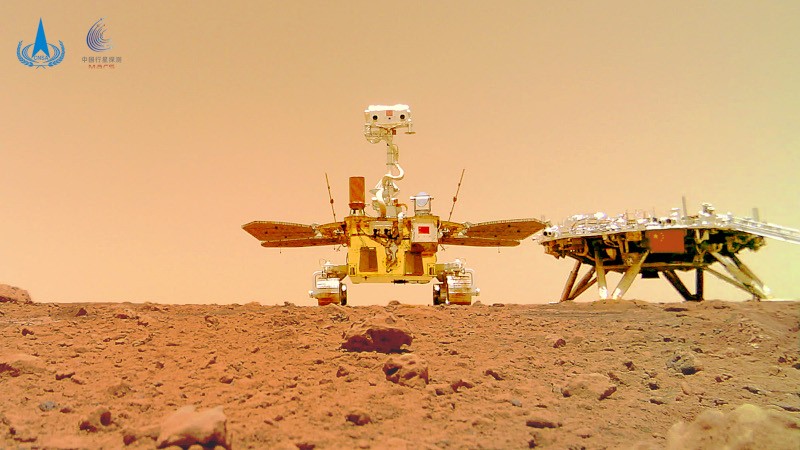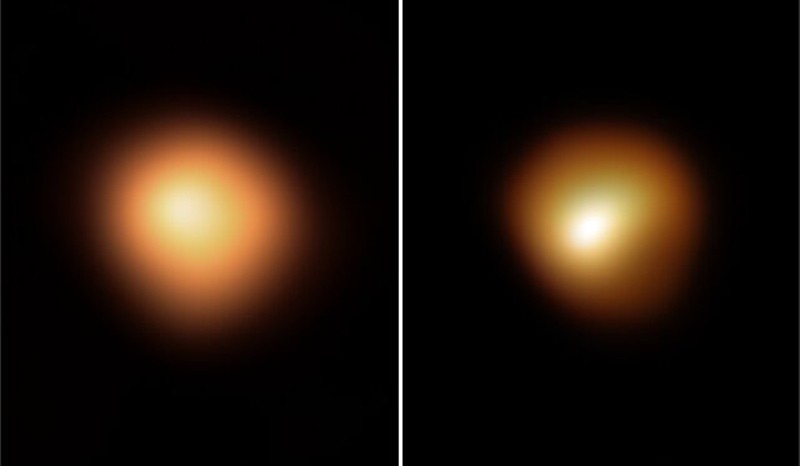China’s Zhurong Mars rover snaps self-portrait
The Chinese rover Zhurong landed on the red planet on 15 May. Now, a flurry of images taken by the rover itself and from spacecraft in Mars’s orbit are capturing its activities. This shot — released by the China National Space Administration (CNSA) on 11 June — was taken by a detachable camera that Zhurong dropped ten metres away before returning to the lander.
A scientifically important image was a high-resolution colour shot taken by NASA’s Mars Reconnaissance Orbiter (MRO), which offers scientists an extremely detailed view of the landing site.
“It’s incredible!” says Peter Grindrod, a planetary scientist at the Natural History Museum in London, who confirmed that the 6 June image revealed Zhurong had by then made reasonable headway, travelling 22 metres from the lander.
NASA and the CNSA are not collaborating on this mission, but Alfred McEwen, a planetary scientist at the University of Arizona in Tucson, and principal investigator for the HiRISE camera on the MRO, suggests the image could be used by Chinese researchers to help plot Zhurong’s route.
“Maybe they will see something of interest,” he says.
Further images in black and white, released by the CNSA and taken by the Tianwen-1 spacecraft that carried Zhurong to Mars, show the rover’s landing site, both before and after it arrived.
Why Betelgeuse went mysteriously dim last year
Normally, Betelgeuse is one of the ten brightest stars in the night sky. In February 2020, however, astronomers noticed that the star’s brightness had dropped by an unprecedented two-thirds.
The dimming fuelled speculation that Betelgeuse could be about to explode, but many astrophysicists pointed out that it was likely to be caused by more mundane mechanisms, such as a blob of unusually cold matter appearing on the star’s surface in what’s known as a convective cell, or a cloud of dust crossing our line of sight to it.
Now, researchers have found that the dimming was probably caused by a combination of both of those factors (M. Montargès et al. Nature 594, 365–368; 2021).
A series of high-resolution images of the star using the Very Large Telescope in Chile’s Atacama Desert showed that the position of the darker region did not change substantially over the imaging period. This indicated that the dim spot was caused by a cloud of dust that had come from the star itself.
The researchers think that an unusually cool convective cell led to a temperature drop in Betelgeuse’s atmosphere. This enabled gas that the star had spewed out in the previous year to condense quickly into dust, blocking out light from the star.
Journal closure leads to dip in papers’ citations
Papers published in a now-defunct business journal get 20% fewer citations than do similar articles published in titles that are still running, according to an analysis of finance scholars’ citing behaviour.
The findings suggest that researchers are “fixated” on the prestige of the journal that a paper is published in, the study’s authors conclude (A. Rubin and E. Rubin J. Polit. Econ. https://doi.org/10.1086/715021; 2021).
The Journal of Business was once considered one of the top five finance-research journals. In 2004, its publisher, Chicago University Press in Illinois, decided to discontinue the title for administrative reasons. The journal officially closed in 2006 and published no new research from that point on. To see how the closure affected citations of the journal’s papers, researchers matched articles published in the Journal of Business between 1995 and 2006 with articles published in one of the other four top-tier finance journals. They then tracked the citations of almost 3,000 articles over the following 10 years.
Articles published in the now-defunct title received 20% fewer citations than did those in journals that are still operating. Even when matched articles had similar topics or findings, those published in the Journal of Business got fewer citations.
The study is a “provocative contribution” to our understanding of how scientists work, says Flaminio Squazzoni, a social scientist at the University of Milan, Italy. But he adds that when a journal is discontinued, the attention of researchers and scientific debate will inevitably go elsewhere.
"impact" - Google News
June 23, 2021 at 03:15PM
https://ift.tt/3qk1bMm
Mars selfie, Betelgeuse mystery and the impact of journal closure - Nature.com
"impact" - Google News
https://ift.tt/2RIFll8
https://ift.tt/3fk35XJ
Bagikan Berita Ini

















0 Response to "Mars selfie, Betelgeuse mystery and the impact of journal closure - Nature.com"
Post a Comment